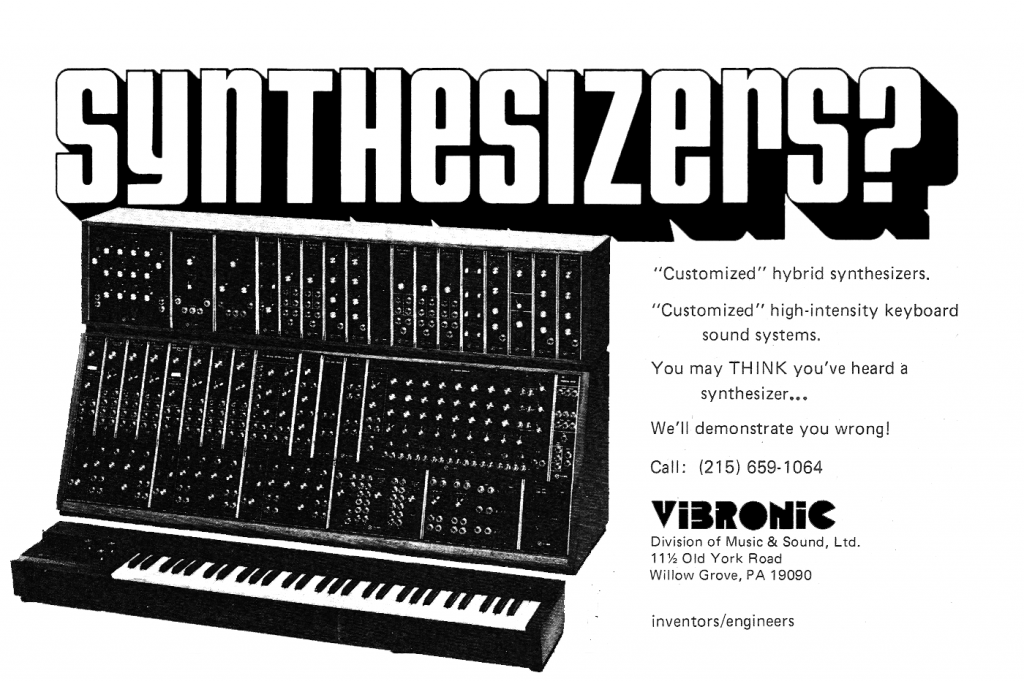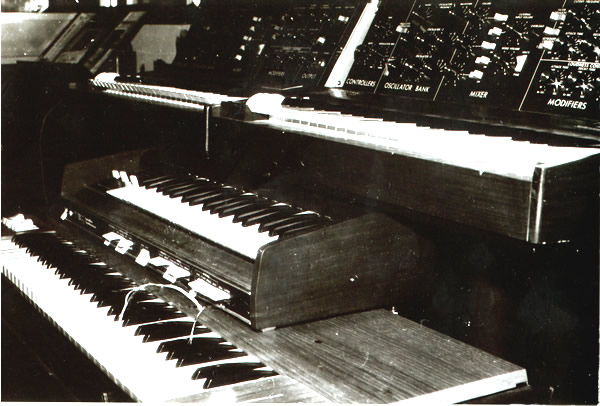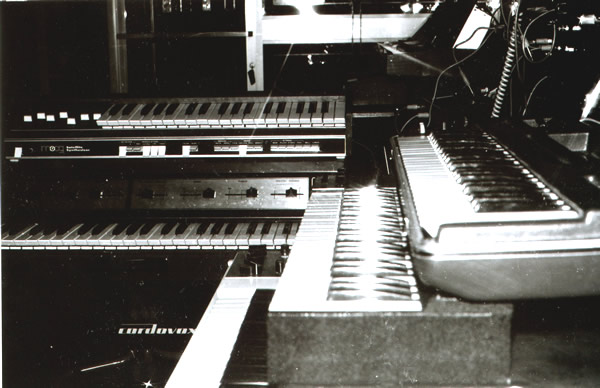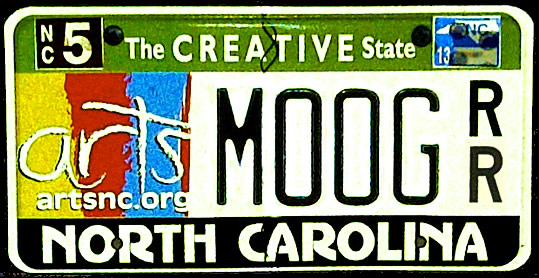Moog & Vibronic Interview Part 3

Vibronic Music Systems “Synthesizers?” half-page black and white advertisement version #2 from page 37 in the March/April 1976 issue of Contemporary Keyboard.
This third and final advertisement from Vibronic only seems to have appeared once in the March/April 1976 issue of CK. After this ad ran (as discussed in my last blog post that featured the previous version of this Vibronic ad) I learned that owner Ken Fine made the decision that marketing dollars could be better spent by advertising directly to local musicians and educators.
The ad itself borrows the ad-title and photography from the previous ad, but the ad-copy has been reduced considerably, but those few lines carry a lot of history..
“Customized” hybrid systems: In past ads, Vibronic really focused on Moog synthesizers and Moog modifications. But in this advertisement the word Moog is curiously missing. In fact, I learned that Vibronic carried a much wider selection of synthesizers and keyboards than just the Moogs of the time. He recalls the store carry the Moog Sonic Six, Moog satellte (tough to sell), Minimoog, large Moog modular systems, as well as EMS, ARP synths and Mellotrons, among others.
“Customized” high-intensity keyboard sound systems: If you recall from the first ad blog post, those customized systems were created by Music & Sound Ltd. And if you recall from my second blog post, they demonstrated those synthesizers to clients through their own customized sound system. Each synth was hooked into a matrix sound system like those found in today’s stores, and then fed into a McIntosh amp and large speaker cabinets hung by chains from the ceiling. Not a surprise – adjacent businesses were often complaining about the sound. 🙂
Even the company name and address in the ad have some good history behind it. Ken had come up with the name Vibronic by putting together the words “Vibration” and “Sonic”, although there were plans to change the name to Vibronix at a future date.
The address in all three ads was actually the store’s second location. He originally opened the store in Ardmore, PA, about 10 miles west of Philadephia, at 6 East Lancaster Ave. That is where the futuristic showroom and that first large custom-built sound system were located. Ken recalls that there was a Radio Shack across the street the got a lot of repeat business from Vibronics at the time. In fact, Ken still has a box of all types of cables and connectors that were originally from that store.
The second location was actually Music & Sound Ltd’s address, where he moved Vibronic after the first year in operation. His partner, Marc Paturka, had left the company and moving into M&S’s location would save money as well as give him more exposure since they were a well-known retailer in those parts. Moving into M&S also allowed Ken to spend more time doing consulting work with studios and schools and keep up his chops as a session player at Sigma Sound and Philly International Records. Ken continued to own the company Vibronic, but included that “Division of Music & Sound Ltd ” above the address in this advertisement as a way of creating a larger company image.
I always jump at the chance to research and talk with people who were deep in the industry during this time period. People like Marco Alpert of E-mu fame and Sequential Circuits advertising artist John Mattos. They usually have some great history to share. And Ken Fine fits nicely into this category. He was surrounded by music all his life – before, during and after Vibronic.
Pre-Vibronic
Ken remembers growing up surrounded by artists in his family. Most were entertainers in some way, always trying to find that balance between art and business. He was primarily a piano player, who then studied at the Philadelphia Musical Academy in the early 1970s. He recalled finding a Moog IIIc in the school’s Music department, where students were using it to record compositions. And as an undergrad he had access. Ken was already fascinated with, as he put it, “the crazy electronic stuff”. He became influenced by many electronic artists and their music of the day, including Isao Tomita’s Snowflakes are Dancing.
Upon graduation from music school in roughly 1973, he ended up working at an electronics company called Components in Minneapolis, and that’s when he started to go out and visit synthesizer factories like Moog and EML. He visited the Moog factory in Buffalo, and it was around this time that he realized he really wanted to sell synthesizers. He began speaking with others in the synthesizer industry like ARP owner Alan R. Perlman (Ken recalls having an ARP synthesizer back then) and this solidified his resolve to get into the business. And after only a year in Minneapolis, he moved back to PA to get to work on that plan.
Philadelphia Moog Ensemble
But he ended up spending just as much time demonstrating the gear to students and curious on-lookers after the concerts – and he found he liked the educational side of synthesizers.
But there was a recession back in 1975/76, so sales really began to drop off. At the same time, larger stores started selling more synthesizers, buying bulk from the likes of Moog and receiving massive discounts. Small boutique synthesizer stores like Vibronic started to feel the squeeze. By 1977, Ken decided a change was in order, and decided to returned to graduate school.
He sold his entire inventory. Ouch.
Post Vibronic
But even as graduate school pulled him away from music, he continued to keep one foot in the door, playing in bands and at clubs. To help pay the bills he also worked part time at Guitar Center, just as polyphonics began to make their rise in popularity and come down in cost.
In 2000 Ken left his psychology private practice in Florida and Colorado, and decided it was time for another life change. He joined a band and spent four months on a cruise ship. This led Ken to look into becoming a booking agent. And he soon opened up a new business – Blue Moon Talent Entertainment Agency.
Ken has continued to grow the talent roster over the last ten years or so to over 1000 acts, now booking acts for corporate events, high-end weddings, banquets and award ceremonies all over the country.
“Never take your art to seriously. Always have fun making money.”
Good advice.
And you can see he practices what he preaches just by looking at his current license plate.
Author: RetroSynthAds.



